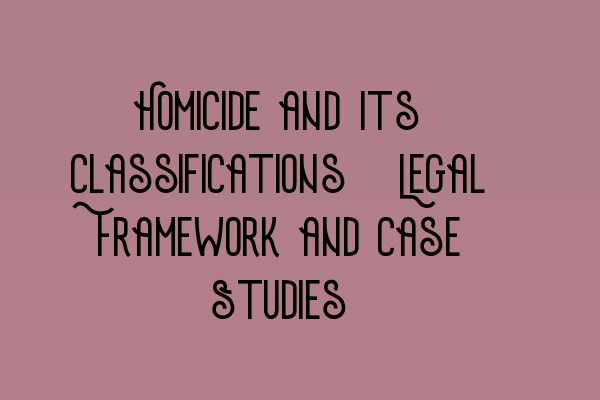Homicide and Its Classifications: Legal Framework and Case Studies
When it comes to criminal law, one of the most serious offenses a person can commit is homicide. Homicide refers to the act of causing the death of another individual, either intentionally or unintentionally. The legal framework surrounding homicide is complex, with different classifications and degrees depending on the circumstances of the crime. In this article, we will explore the legal aspects of homicide, its various classifications, and provide case studies to illustrate the application of these classifications.
Understanding Homicide
Homicide can be broadly classified into two categories: murder and manslaughter. Murder involves the intentional killing of another person with malice aforethought, while manslaughter refers to the unintentional killing of another person. Within these categories, there are further classifications based on the circumstances surrounding the crime.
Classifications of Homicide
In the legal framework, the classifications of homicide include:
- Murder: Murder is the most severe classification of homicide. It involves the intentional killing of another person with malice aforethought. The presence of malice aforethought indicates the intent to cause harm or death.
- Voluntary Manslaughter: Voluntary manslaughter refers to the intentional killing of another person without malice aforethought. It usually occurs in the heat of the moment, as a result of sudden provocation or when the defendant acts under extreme emotional distress.
- Involuntary Manslaughter: Involuntary manslaughter occurs when a person causes the death of another person unintentionally, but as a result of their reckless or negligent actions. It lacks the intent present in murder and voluntary manslaughter cases.
- Corporate Manslaughter: Corporate manslaughter is a classification of homicide that applies to organizations or corporations. It holds them accountable for deaths caused by their gross negligence or failure to fulfill their duty of care.
These classifications play a crucial role in determining the severity of the offense and the corresponding legal penalties. It is essential for criminal law practitioners to understand the nuances of each classification to build a strong defense or prosecution.
Case Studies
Examining real-life case studies can provide valuable insights into how these classifications are applied in practice. Here are a few notable examples:
- Case Study 1: R v Brown – This case involved a group of individuals engaging in consensual sadomasochistic activities that resulted in the death of one participant. The defendants were charged with murder but successfully argued that their actions amounted to voluntary manslaughter due to mutual consent and no malice aforethought.
- Case Study 2: R v Misra – In this case, the defendant had intended to kill her husband but accidentally administered a lethal dose of insulin to her ex-lover instead. The court ruled it as involuntary manslaughter as the defendant did not have the intent to cause harm to the deceased.
- Case Study 3: R v Lionnet – Here, the defendants were charged with corporate manslaughter after a young au pair died due to the negligence and abuse inflicted upon her by her employers. The court found the defendants guilty and held the corporation accountable for their gross negligence.
These case studies highlight the importance of understanding the intricate details of each classification to effectively navigate the legal system and ensure justice is served.
At SQE Criminal Law & Practice Law UK, we offer comprehensive training and preparation courses for aspiring solicitors. Our SQE 1 Practice Exam Questions and SQE 1 Practice Mocks FLK1 FLK2 provide valuable practice opportunities to enhance your knowledge and skills. We also offer SQE 2 Preparation Courses to prepare you for the practical aspects of criminal law practice. Stay updated with the latest SRA SQE Exam Dates to plan your journey towards becoming a qualified solicitor.
In conclusion, homicide is a serious offense with various classifications that play a crucial role in the legal framework. Understanding the nuances of each classification and their application through case studies is essential for legal professionals working in the field of criminal law. By continuously improving your knowledge and skills, you can effectively navigate the complexities of homicide cases and contribute to the pursuit of justice.
